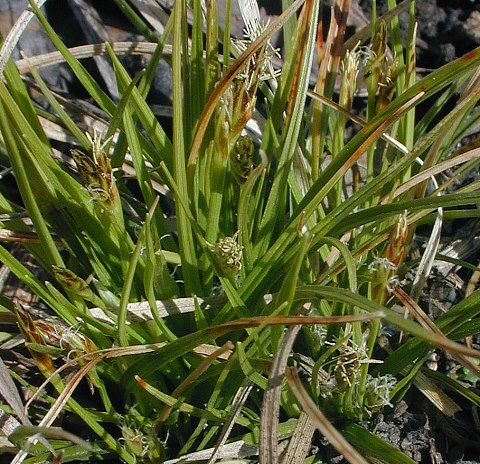Description: This perennial sedge consists of a dense tuft of leaves and short flowering culms. The erect to ascending culms are 1-4" long, 3-angled, light green, and glabrous. Alternate leaves are located toward the bottom of each culm. The ascending to spreading leaf blades are up to 6" long and 1/8" across (3 mm.); they are light green, glabrous, and furrowed. Remnants of older leaf blades are evident around the base of each tufted plant; they are light gray to brown. Each longer culm (2-4" in length) terminates in an inflorescence consisting of a single staminate (male) spikelet and 1-3 lateral pistillate (female) spikelets. In this case, the pistillate spikelets are adjacent to the staminate spikelet; they are sessile (or nearly so). In contrast, each short culm (about 1" in length) produces 1-3 pistillate spikelets and no staminate spikelets. The bracts of each inflorescence resemble slender green scales; they are inconspicuous. Each staminate spikelet is up to ½" long; it is elongated and flattened, consisting of several staminate florets and their scales, which are arranged in 2 columnar ranks. Each staminate floret has 3 stamens with elongated anthers; the anthers are white to cream-colored. The staminate scales (while young) are reddish brown with a green vein in the center; they are about 3 mm. long and broadly lanceolate in shape. Each pistillate spikelet is up to 1/3" (8 mm.) long, consisting of about 3-10 perigynia, pistillate florets, and their scales. Individual perigynia are 2.5–3.0 mm. long (including the beak); each perigynium is globoid in the middle, becoming stipe-like at the bottom and abruptly tapering to a short straight beak (0.5-1.0 mm. long) at the apex. Young perigynia are light green and finely pubescent along their upper halves (a 10x hand lens may be required to see the pubescence). The stigmata of the pistillate florets are white and filiform (very slender, worm-like). The pistillate scales are about the same length as the perigynia; they are similar to the staminate scales in their characteristics.

The blooming
period occurs during mid-spring for about 2 weeks. The florets are
cross-pollinated by the wind. The perigynia and their achenes become
mature during the early summer. The achenes are globoid-ovoid, slightly
3-angled, hairless, and about 1.5 mm. long. The root system is
short-rhizomatous and fibrous. Later in the year, the leaves of the
flowering culms are replaced by basal leaves that are partially
evergreen; they are similar to the alternate leaves, but longer and
more widely spreading.
Cultivation:
The preference is full to partial sun, dry-mesic to dry conditions, and
soil that is sandy or rocky. However, this sedge will adapt to rich
loamy soil if taller and more aggressive plants are kept away from it.
Because of its compact habit, it is a suitable candidate for rock
gardens.
Range & Habitat:
The native Hidden Sedge is occasional in parts of northern,
west-central, and
southern Illinois, otherwise it is rare or absent. Habitats include dry
sand prairies, dry dolomite prairies, sandy or rocky upland savannas,
sandstone glades and cliffs, thinly wooded slopes and ridges, and sand
dunes. In sandy areas where trees are present, Hidden Sedge is often
associated with Quercus velutina (Black Oak) and Pinus
banksiana (Jack Pine). This sedge is normally found in higher
quality natural areas and it probably benefits from occasional
wildfires.
Faunal Associations:
This upland sedge is a food source of various insects, including
aphids, stinkbugs, plant bugs, moth caterpillars, and grasshoppers (see
Grasshopper
Table). The seeds are reportedly distributed by ants, which
may explain why its spikelets are hidden by the foliage. The seeds are
consumed by both upland gamebirds and songbirds (see Bird Table);
they are also eaten by the Prairie Vole and probably other small
rodents.
Photographic Location:
The wildflower garden of the webmaster in Urbana, Illinois.
Comments:
Hidden Sedge develops early in the spring and blooms before canopy
trees produce their leaves. This small and inconspicuous sedge is
rather unusual because its low flowering culms are partially hidden by
the leaf blades. Rather than being regarded as distinct species, Carex
abdita is sometimes considered a scientific synonym of Carex
umbellata (Early Oak Sedge); it has also been regarded as a
variety of the latter species, Carex umbellata brevirostra.
Hidden Sedge and Early Oak Sedge are very similar to each other, but
they are supposed to differ in the following characteristics: 1) Hidden
Sedge has shorter beaks (0.5–1.0 mm.) on its perigynia than Early Oak
Sedge, and 2) the perigynia of Hidden Sedge are smaller (2.5–3.0 mm.)
than those of Early Oak Sedge. Other small sedges with hidden flowering
culms include Carex nigromarginata (Black-Margined
Sedge) and Carex tonsa (Shaved Sedge).
Black-Margined Sedge has perigynia that are more ellipsoid in shape,
while the staminate spikelets and pistillate spikelets of Shaved Sedge
are never adjacent to each other (the former are more elevated than the
latter).